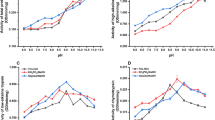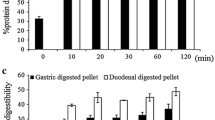Abstract
In their larval luminal midgut fluid,Trichoplusia ni (Lepidoptera: Noctuidae) andPieris rapae (Lepidoptera: Pieridae) contain endopeptidases as their primary proteases. Neither species has detectable exopeptidase activity. Studies using enzyme-specific substrates and inhibitors demonstrate that the endopeptidases are serine proteinases (both trypsinlike and chymotrypsinlike) with histidine at the active site. Optimal pH for the tryptic and chymotryptic activity is 8.5 and 8.0, respectively, forT. ni. and 8.0 and 9.0, respectively, forP. rapae. The efficiency of proteolytic digestion (as measured by the rate of in vitro digestion of a standard protein by the midgut luminal fluid) is positively correlated with the larval dietary protein requirement and is significantly influenced by the ratios of tryptic to chymotryptic activity present in the gut lumen of these two species of Lepidoptera.
Similar content being viewed by others
References
Baker, J.E. 1977. Substrate specificity in the control of digestive enzymes in larvae of the black carpet beetle.J. Insect Physiol. 23:749–753.
Baker, J.E. 1981. Resolution and partial characterization of the digestive proteinases from larvae of the black carpet beetle, pp. 283–315,in G. Bhaskaran, S. Friedman, and J.G. Rodriguez (eds.). Current Topics in Insect Endocrinology and Nutrition. Plenum, New York.
Berenbaum, M. 1980. Adaptive significance of midgut pH in larval Lepidoptera.Am. Nat. 115:138–146.
Broadway, R.M. 1988. Tryptic inhibitory activity in wild and cultivated crucifers.Phytochemistry. 28:755–758.
Broadway, R.M., andDuffey, S.S. 1986a. The effect of dietary protein on the growth and digestive physiology of larvalHeliothis zea andSpodoptera exigua.J. Insect Physiol. 32:673–680.
Broadway, R.M., andDuffey, S.S. 1986b. Plant proteinase inhibitors: Mechanism of action and effect on the growth and digestive physiology of larvalHeliothis zea andSpodoptera exigua.J. Insect Physiol. 32:827–833.
Broadway, R.M., andDuffey, S.S. 1988. The effect of plant protein quality on insect digestive physiology and the toxicity of plant proteinase inhibitors.J. Insect Physiol. 34:1111–1117.
Broadway, R.M., Duffey, S.S., Pearce, G., andRyan, C.A. 1986. Plant proteinase inhibitors: A defense against herbivorous insects?Entomol. Exp. Appl. 41:33–38.
Cha-Yun, S., andChen, B. 1982. Comparison of the effects of insect intestinal proteases on the crystals ofBacillus thuringiensis.Acta Entomol. Sin. 25:244–249.
Chen, I., andMitchell, H.L. 1973. Trypsin inhibitors in plants.Phytochemistry 12:327–330.
Espinoza-Fuentes, P.P., andTerra, W.R. 1987. Physiological adaptations for digesting bacteria.Insect Biochem. 17:809–817.
Folk, J.E., Piez, K.A., Carroll, W.R., andGladner, J.A. 1960. Carboxypeptidase B. IV. Purification and characterization of the porcine enzyme.J. Biol. Chem. 235:2272–2277.
Gatehouse, A.M.R., Butler, K.J., Fenton, K.A., andGatehouse, J.A. 1985. Presence and partial characterisation of a major proteolytic enzyme in the larval gut ofCallosobruchus maculatus.Entomol. Exp. Appl. 39:279–286.
Gold, A.M. 1965. Sulfonyl fluorides and inhibitors of esterases. III. Identification of serine as the site of sulfonylation of phenylmethane-sulfonyl chymotrypsin.Biochemistry 4:897–901.
Goldstein, J.L., andSwain, T. 1965. The inhibition of enzymes by tannins.Phytochemistry 4:185–192.
Gothilf, S., andBeck, S.D. 1967. Larval feeding behaviour of the cabbage looper,Trichoplusia ni.J. Insect Physiol. 13:1039–1053.
Hilder, V.A., Gatehouse, A.M.R., Sheerman, S.E., Barker, R.F., andBoulter, D. 1987. A novel mechanism of insect resistance engineered into tobacco.Nature 330:160–163.
Hummel, B.C.W. 1959. A modified spectrophotometric determination of chymotrypsin, trypsin, and thrombin.Can. J. Biochem. Physiol. 37:1393–1399.
Ishaaya, I., Moore, I., andJoseph, D. 1971. Protease and amylase activity in larvae of the Egyptian cottonworm,Spodoptera littoralis.J. Insect Physiol. 17:945–953.
Law, J.H., Dunn, P.E., andKramer, K.J. 1977. Insect proteases and peptidases.Adv. Enzymol. 45:389–425.
Maguire, L.A. 1984a. Choosing host plant patch sizes for experiments onPieris rapae (L.) populations (Lepidoptera: Pieridae).Environ. Entomol. 13:459–463.
Maguire, L.A. 1984b. Influence of surrounding plants on densities ofPieris rapae (L.) eggs and larvae (Lepidoptera: Pieridae) on collards.Environ. Entomol. 13:464–468.
Martin, M.M., andMartin, J.S. 1984. Surfactants: Their role in preventing the precipitation of proteins by tannins in insect guts.Oecologia 61:342–345.
Martin, M.M., Kukor, J.J., Martin, J.S., Lawson, D.L., andMerritt, R.W. 1981. Digestive enzymes of larvae of three species of caddisflies (Trichoptera).Insect Biochem. 11:501–505.
McClure, W.O., Neurath, H., andWalsh, K.A. 1964. The reaction of carboxypeptidase A with hippuryl-dl-β-phenyllactate.Biochemistry 3:1897–1901.
Meisner, J., Ishaaya, I., Ascher, K.R.S., andZur, M. 1978. Gossypol inhibits protease and amylase activity ofSpodoptera littoralis Boisduval larvae.Ann. Entomol. Soc. Am. 71:5–8.
Metcalf, C.L., Flint, W.P., andMetcalf, R.L. 1962. Destructive and Useful Insects. McGraw-Hill, New York.
Miller, M.W., Kramer, K.J., andLaw, J.H. 1974. Isolation and partial characterization of the larval midgut trypsin from the tobacco hornworm,Manduca sexta, Johannson (Lepidoptera: Sphingidae).Comp. Biochem. Physiol. 488:117–129.
Mole, S., andWaterman, P.G. 1987. Tannic acid and proteolytic enzymes: Enzyme inhibition or substrate deprivation?Phytochemistry 26:99–102.
Narayanan, K., Govindarajan, R., Subramaniam, T.R., andJayaraj, J. 1976. pH of blood and gut contents of lepidopterous insects and its relation to pathogenicity of two bacterial pathogens.Ind. J. Microbiol. 16:65–67.
Renwick, J.A.A., andRadke, C.D. 1988. Sensory cues in host selection for oviposition by the cabbage butterfly,Pieris rapae.J. Insect Physiol. 34:251–257.
Sasaki, T., andSuzuki, Y. 1982. Alkaline proteases in digestive juice of the silkworm,Bombyx mori.Biochim. Biophys. Acta 703:1–10.
Schoellmann, G., andShaw, E. 1963. Direct evidence for the presence of histidine in the active center of chymotrypsin.Biochemistry 2:252–255.
Shaw, E. 1967. Site-specific reagents for chymotrypsin and trypsin, pp. 677–686,in S.P. Colowick and N.O. Kaplan, (eds.). Methods in Enzymology, Vol. 2. Academic Press, New York.
Shorey, H.H., andHale, R.L. 1965. Mass rearing of the larvae of nine noctuid species on a simple artificial medium.J. Econ. Entomol. 58:522–524.
Shorey, H.H., Andres, L.A., andHale, R.L. 1962. The biology ofTrichoplusia ni (Lepidoptera: Noctuidae). I. Life history and behavior.Ann. Entomol. Soc. Am. 55:591–597.
Smith, P.K., Krohn, R.L, Hermanson, G.T., Mallia, A.K., Gartner, F.H., Provenzano, M.D., Fujimoto, E.K., Goeke, N.M., Olson, B.J., andKlenk, D.C. 1985. Measurement of protein using bicinchoninic acid.Anal. Biochem. 150:76–85.
Walsh, K.A. 1970. Trypsinogens and trypsin of varous species, pp. 41–44,in G.E. Perlmann and L. Lorand, (eds.). Methods in Enzymology, Vol. 19. Academic Press, New York.
Walsh, K.A., andWilcox, P.E. 1970. Serine proteases, pp. 31–41,in G.E. Perlmann and L. Lorand (eds.). Methods in Enzymology, Vol. 19. Academic Press, New York.
Ward, C. W. 1975. Resolution of proteases in the keratinolytic larvae of the webbing clothes moth.Aust. J. Biol. Sci. 28:1–23.
Webb, S.E., andShelton, A.M. 1988. Laboratory rearing of the imported cabbageworm. New York Food and Life Science Bulletin, No. 122.
Whitaker, J.R. 1981. Naturally occurring peptides and protein inhibitors of enzymes, pp. 57–104,in J.C. Ayres and J.C. Kirschman (eds.). Impact of Toxicology on Food Processing. AVI Publishers, Westport, Connecticut.
Author information
Authors and Affiliations
Rights and permissions
About this article
Cite this article
Broadway, R.M. Characterization and ecological implications of midgut proteolytic activity in larvalPieris rapae andTrichoplusia ni . J Chem Ecol 15, 2101–2113 (1989). https://doi.org/10.1007/BF01207441
Received:
Accepted:
Issue Date:
DOI: https://doi.org/10.1007/BF01207441




